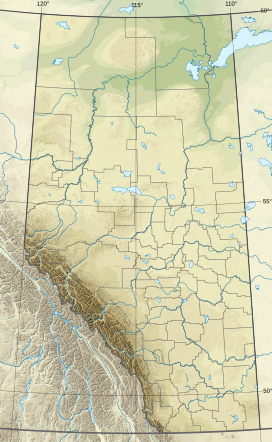Mount Sarbach
| Mount Sarbach | |
|---|---|
 Mount Sarbach seen from Mistaya Canyon | |
| Highest point | |
| Elevation | 3,155 m (10,351 ft)[1] |
| Prominence | 412 m (1,352 ft)[1] |
| Parent peak | Mount Chephren (3274 m)[1] |
| Listing | Mountains of Alberta |
| Coordinates | 51°53′34″N 116°46′05″W / 51.89278°N 116.76806°W[2] |
| Geography | |
| Location | Alberta, Canada |
| Parent range | Waputik Mountains Canadian Rockies |
| Topo map | NTS 82N15 Mistaya Lake[2] |
| Geology | |
| Rock age | Cambrian |
| Rock type | Sedimentary |
| Climbing | |
| First ascent | 1897 by J. Norman Collie, G.P. Baker and Peter Sarbach[1] |
| Easiest route | Difficult Scramble[3] |
Mount Sarbach is a mountain located in Banff National Park between Mistaya River and Howse River and is visible from the Icefields Parkway. The mountain is named after Peter Sarbach, a mountain guide from Switzerland, who guided the first ascent by J. Norman Collie and G.P. Baker in 1897. Mount Sarbach is situated south of Saskatchewan River Crossing, where the Icefields Parkway intersects with the David Thompson Highway.
Geology
[edit]Like other mountains in Banff Park, Mount Sarbach is composed of sedimentary rock laid down during the Precambrian to Jurassic periods.[4] Formed in shallow seas, this sedimentary rock was pushed east and over the top of younger rock during the Laramide orogeny.[5] A glacier shared with Kaufmann Peaks resides in the southeast cirque.
Climate
[edit]Based on the Köppen climate classification, Mount Sarbach is located in a subarctic climate with cold, snowy winters, and mild summers.[6] Temperatures can drop below -20 °C with wind chill factors below -30 °C. Precipitation runoff from Mount Sarbach drains into the Mistaya River and Howse River which are both tributaries of the North Saskatchewan River.
See also
[edit]References
[edit]- ^ a b c d "Mount Sarbach". Bivouac.com. Retrieved 2009-01-02.
- ^ a b "Mount Sarbach". Geographical Names Data Base. Natural Resources Canada. Retrieved 2019-09-14.
- ^ Kane, Alan (1999). "Mount Sarbach". Scrambles in the Canadian Rockies. Calgary: Rocky Mountain Books. pp. 303–304. ISBN 0-921102-67-4.
- ^ Belyea, Helen R. (1960). The Story of the Mountains in Banff National Park (PDF). parkscanadahistory.com (Report). Ottawa: Geological Survey of Canada. Archived (PDF) from the original on 2015-10-02. Retrieved 2019-09-13.
- ^ Gadd, Ben (2008). Geology of the Rocky Mountains and Columbias.
- ^ Peel, M. C.; Finlayson, B. L.; McMahon, T. A. (2007). "Updated world map of the Köppen−Geiger climate classification". Hydrol. Earth Syst. Sci. 11 (5): 1633–1644. Bibcode:2007HESS...11.1633P. doi:10.5194/hess-11-1633-2007. ISSN 1027-5606.
External links
[edit]- Parks Canada web site: Banff National Park


